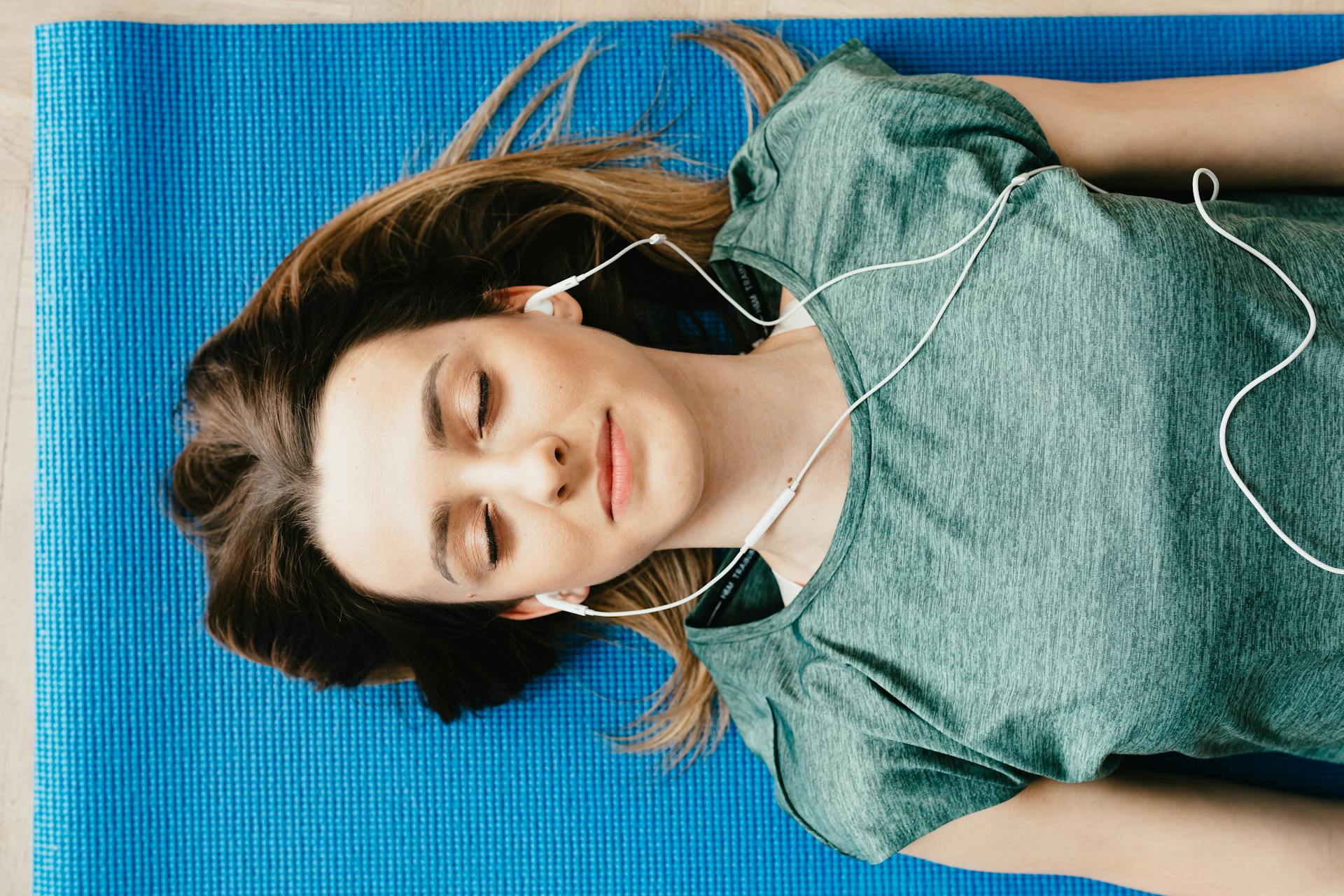You’ve got 20 minutes and a tight chest. You want relief, but you’re staring at two choices: a guided meditation with a calm voice leading you step by step—or a wordless track of ambient music, maybe some rain sounds.
Both are called meditation. Both claim to help with stress. But when your nervous system is buzzing, how do you know which one is actually going to help?
The answer depends on your current stress level, your experience with meditation, and what your mind and body need in that moment.
This guide will help you figure out when to choose guided vs. unguided meditation audio—and how to use both strategically to support your emotional regulation, mental clarity, and healing.
🧘♀️ First, What’s the Difference?
▶️ Guided Meditation Audio:
This type features a speaker—often a soft, calm voice—guiding you through breathwork, visualization, body scans, affirmations, or mindfulness practices.
Typical formats include:
- Breath-focused guidance (“Inhale slowly… now exhale.”)
- Visualization meditations (“Picture a calm lake…”)
- Body scan relaxation
- Affirmation-based sessions
- Trauma-informed or self-compassion meditations
These are often paired with background music or ambient noise but rely on vocal instruction to hold your focus.
🔇 Unguided Meditation Audio:
This is wordless and offers sound-only support. It may include:
- Nature sounds (rain, forest, ocean)
- Solfeggio frequencies or healing tones
- Singing bowls, chimes, bells
- Ambient or drone-style music
- Silence with subtle cues
- Binaural beats
You’re left to guide yourself, whether that means focusing on your breath, observing thoughts, or just being.
🤔 Which One Works Better for Stress Relief?
Here’s the truth: it depends on the kind of stress you’re carrying—and your comfort with silence.
Let’s break it down by stress level, using real-world examples and practical advice.
🚨 High-Stress or Anxiety State: Choose Guided
If you’re feeling:
- Restless, racing thoughts
- Overwhelmed or panicked
- Scattered attention
- Physically tense
- Afraid to “be alone” with your thoughts
Then a guided meditation audio is likely your best choice.
Why Guided Works Here:
- Structure reduces decision fatigue
You don’t have to figure out “what to do” next. - Voice provides co-regulation
A calm, steady voice can help mirror calmness back to your nervous system. - Interrupts looping thoughts
Verbal cues can pull you out of rumination. - Emotional safety
Trauma-informed meditations (like those from Insight Timer or Sarah Blondin) create a held, nonjudgmental space.
Best Guided Formats for High Stress:
- Body scan meditations (anchor awareness in the body)
- Breath-focused cues (4-7-8 or box breathing)
- Compassion meditations (reduce self-criticism)
- Grounding visualizations (safe place imagery, tree roots, warm light)
🧠 Pro tip: Use headphones for a more intimate experience. The voice can feel like a protective container—especially if the outside world feels chaotic.
😣 Mild to Moderate Stress: Try Guided or Soft Unguided
If you’re feeling:
- Tired but not panicked
- Foggy or mentally cluttered
- Irritated or low-energy
- Distracted and unmotivated
You’re in the middle zone—and either type of meditation could work. The choice depends on how much you want support vs. need silence.
Guided Meditation Benefits:
- Kickstarts focus when your attention feels scattered
- Encourages emotional processing through prompts
- Keeps you from “checking out” or falling asleep
Unguided Audio Benefits:
- Allows deeper inner listening
- Creates space to just “be”
- Helps you discover your natural rhythm without external pacing
Great Unguided Options for Moderate Stress:
- Rain or ocean sounds + slow breath
- Ambient music (e.g., Liquid Mind, East Forest)
- Low-frequency tones (like 432 Hz for grounding)
- Tibetan bowls or Solfeggio frequencies
💡 Tip: Try pairing 3–5 minutes of guided meditation to settle in, then switch to unguided ambient audio for the rest of the session. This hybrid approach is great for transition periods.
🧘 Low Stress, Seeking Clarity or Spiritual Practice: Use Unguided
If you’re feeling:
- Emotionally stable or calm
- Curious or contemplative
- Energetically open
- Ready to go deeper inward
Unguided meditation audio gives you spaciousness—freedom to explore, feel, and connect with your breath, body, or intuition without interruption.
Why Unguided Works Here:
- Allows natural thought surfacing without redirection
- Promotes creative insight or emotional integration
- Supports advanced practices like non-dual meditation, loving awareness, or breath awareness
Ideal Unguided Tools:
- Solfeggio frequencies for energy tuning
- Binaural beats for brainwave exploration (alpha/theta)
- Field recordings (waterfalls, wind through trees)
- Silent tracks with subtle bells to mark time
🎵 Example: A 30-minute forest + flute track played during a seated breath meditation can become a deeply restorative ritual for creative professionals or spiritual seekers.
📊 Comparison Chart: Guided vs. Unguided by Use Case
| Use Case | Guided Meditation | Unguided Meditation |
|---|---|---|
| Panic or racing mind | ✅ Best for focus & support | ❌ May feel too unstructured |
| Falling asleep | ✅ Guided body scan or affirmations | ✅ Looped rain or pink noise |
| Emotional processing (grief, heartbreak) | ✅ Helps explore emotions with care | ⚠️ Can feel overwhelming alone |
| Morning mindfulness | ✅ Sets intention | ✅ Lets you set your own rhythm |
| Deep spiritual meditation | ⚠️ May interrupt deep silence | ✅ Best for inner stillness |
| Background calming during chores | ❌ Voice may distract | ✅ Music or nature sounds ideal |
| New to meditation | ✅ Encourages commitment & flow | ⚠️ Hard to stay focused without training |
🧠 Psychological and Neurological Differences
Let’s briefly touch on how your brain responds to each.
🧠 Guided Meditation:
- Activates prefrontal cortex (decision-making, attention)
- Encourages cognitive reframing if affirmations are used
- Offers verbal anchors that reduce DMN (default mode network overactivity, aka “mind wandering”)
🧠 Unguided Meditation:
- Can activate theta brainwaves more deeply (intuitive states)
- Allows space for emotional and somatic integration
- May increase interoception (awareness of internal bodily sensations)
Both forms have been shown in studies to:
- Lower cortisol
- Improve HRV (heart rate variability)
- Boost GABA (calming neurotransmitter)
- Strengthen gray matter in areas associated with focus and compassion
But they get there through different routes—verbal guidance vs. non-verbal experience.
💬 What Real Users Say
“When I’m super anxious, I need someone’s voice telling me I’m okay. I don’t want silence—it makes me spiral.”
— Jasmine, 31
“At night, unguided rain sounds and brown noise are my go-to. I can’t sleep with voices—it keeps my mind awake.”
— Ethan, 38
“Guided meditations helped me learn how to focus. Now I mostly use music and breath. It’s like training wheels—useful when you need them.”
— Nina, 27
“I thought unguided would be hard, but once I got used to it, I started having these quiet moments of insight I never got with voice.”
— Kofi, 44
🔄 When to Switch from One to the Other
If you’re stuck or plateauing, it might be time to change your format.
Switch to guided if:
- You’re bored or falling asleep during unguided sessions
- You’re getting lost in rumination or mental noise
- You want to explore new themes (forgiveness, body love, grief, etc.)
Switch to unguided if:
- You crave silence and space
- You’ve done the same guided script too many times
- You feel ready to explore your internal world without external input
Let your body and nervous system guide your shift. If a voice feels intrusive, go silent. If silence feels chaotic, invite a voice in.
📱 Where to Find the Best of Both
Guided Meditation Audio:
- Insight Timer (free + premium)
- Calm (great for body scans and sleep)
- Headspace (structured programs)
- Ten Percent Happier (great for anxiety and skeptics)
Unguided Meditation Audio:
- MyNoise.net (customizable ambient mixes)
- Brain.fm (binaural for focus, sleep, and calm)
- YouTube or Bandcamp (search for Solfeggio, brown noise, nature sounds)
- Amazon MP3 (permanent downloads of ambient artists like Liquid Mind)
✨ Final Takeaway: Your Nervous System Knows What It Needs
There’s no “right” answer for everyone—just the right support for the moment you’re in.
Ask yourself:
- Do I need structure or space?
- Do I want to be led or left alone?
- Does my body crave stillness or soothing sound?
Stress isn’t always a shout. Sometimes it’s a whisper. And sometimes, silence is too loud. Whether you use a gentle voice or soft tones, your goal isn’t to “meditate perfectly”—it’s to remember your own calm beneath the noise.
So don’t be afraid to mix it up.
Try both.
Feel your way.
Build a ritual that supports you—not the app.

